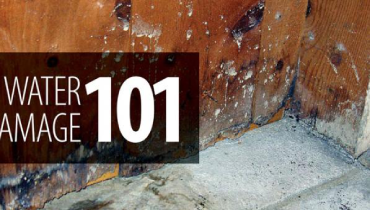
Rainbow Restoration highlights these essential steps to safeguard your home from water damage.
|
A flood can wreak havoc on your home. Even if you don’t live in a flood zone, your house is still susceptible to water damage from plumbing fixtures. You take the pipes that transport water throughout your home for granted, but if something goes wrong, you could quickly become very aware of them. Learn more about preventing water damage, detecting leaks and recovering from a major water leak.
How to Prevent Water Leaks and Damage
It’s possible to recover from water leaks and make an insurance claim to cover the damage, but you might be able to prevent the whole fiasco with a few preventative measures:
- Be careful what and where you plant: Tree roots can be incredibly invasive, so learn more about the location of underground pipes, sprinkler lines and septic tanks before you plant a new tree.
- Clean out your gutters: Gutters have the important job of directing rainwater from the roof away from the foundation. Clogged gutters allow water to spill over the sides, which can send water flowing down to the basement where it could do serious damage. Make it a habit to clean the gutters twice a year – once in the spring and again in the fall.
- Install a sump pump: Flooding from rainstorms starts in the basement. Prevent this by installing a sump pump, an especially important investment if you live in a rainy climate. This device pumps water rising up from the ground back to the outside so your basement and the rest of your home stays dry.
- Upgrade to reinforced hoses: Washing machines and dishwashers get their water supply from hoses. Check these regularly to make sure they’re not kinked, blistered, bulging or cracked. When they show signs of wear, replace your existing hoses with reinforced stainless steel versions, which are stronger and last longer than rubber or plastic hoses.
- Install water shut-off valves: A manual valve attached the washing machine’s water supply lets you turn it off any time you’re not using the appliance. An automatic water-sensing system shuts off water to specific appliances or the entire house if it detects a leak. These devices give you peace of mind and drastically reduce the chances of water damage to your home.
- Take good care of your pipes: A burst, or leaky pipe is a major cause of water damage. To help your pipes stay in good condition:
- Use a drain snake instead of unclogging chemicals when a sink starts to back up.
- Never pour grease or oil down the drain.
- On cold nights, set the thermostat to at least 60 degrees and open under-sink cabinet doors so warm air can circulate around pipes and help prevent them from freezing.
- Test your water pressure. If it’s above the recommended psi for your area, hire a plumber to reduce the pressure and subsequently add years to the life of your plumbing system.
How to Detect Leaks
Early detection can help keep water damage to a minimum. Be a leak detective with these tips:
- Examine your water bills and water meter: If you notice a sudden unexplained cost increase in your monthly bills, you could have a hidden leak. Go outside and read your water meter. Don’t use any water for two hours. Read the meter again. If it has moved, you’ve just confirmed you have a leak somewhere.
- Check everywhere possible for the leak: Anything with water attached to it has the potential to leak. This includes sinks, toilets, tubs, showers, the ice maker, dishwasher and washing machine. Check around these fixtures and appliances, looking for water stains, cracked pipes, damaged rubber tubing, loose fittings and other signs of damage. Don’t forget to check ceilings and walls in rooms below potentially leaky bathrooms, kitchens and laundry rooms for water stains and soggy spots.
What to Do After a Flood or Major Water Leak
Follow these steps to reduce the damage caused by a flood or leak. Be sure to contact Rainbow Restoration® immediately to begin the remediation process. Any delay increases the chance of mold damage on top of water damage.
Hopefully, you can avoid water damage with these tips. If not, please contact us for a free water damage mitigation estimate.
For further reading:
